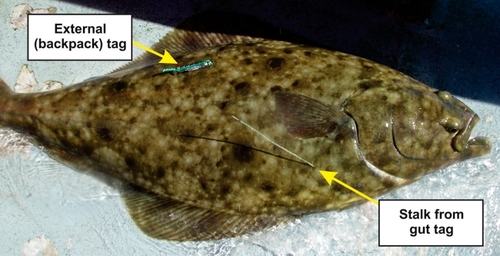Environment Fishery

The International Pacific Halibut Commission is trying a new way of tracking halibut migration using technology invented for smart phones and tablets.
The same high tech that lets your smart phone or tablet know the screen should be horizontal or vertical may help the commission, responsible for the conservation of halibut from the Bering Sea along the Alaska and BC coasts all the way to California, track the migration of the valuable and possibly threatened groundfish.
Commission scientists have tagged 30 halibut in areas 3A (roughly the Gulf of Alaska) and 2C (the Alaska panhandle north from the Canadian border) with a combination of external electronic “backpack tags” and electronic internal “gut tags”
The IPHC says the backpack tag is a black plastic cylinder that measures ~3″ (7.6 cm) long by ½” (1.2 cm) in diameter, It is attached to the dark side of the fish, below the dorsal fin, using a green-coated tagging wire, with a white backing plate that rests on the underside of the fish. Gut tags are surgically implanted in the gut cavity, but have a translucent green stalk that protrudes from the belly on the fish’s dark side. The stalk is made of Teflon, and contains sensors that record ambient light levels.
The commission says the purpose of the study is to examine whether geomagnetism can be used as a means of tracking halibut migrations.
The tags record the local magnetic field in ways that can be converted into location estimates, based on the strength of the magnetic field and magnetic declination angle in relation to the poles (which gets steeper closer to the poles) in combination with depth and light data. The “the pitch and roll detectors” in the phones and tablets that can also track the “the rolling bead in the maze game” do all the calculations needed to track the fish tag.
Since the halibut feeds on the relatively horizontal bottom of the ocean, the angle of the earth’s crust in relation to the poles should be able to track the migration without the use of GPS which cannot penetrate the ocean depths.
All data is recorded in the tag’s memory and can be retrieved if the fish is harvested. There is enough memory and battery capacity that the data can be recorded every 30 seconds for up to seven years. The IPHC is offering a $500 reward to fishers who may catch the halibut to return both tags.
If the pilot project is successful, the IPHC will tag another 2,000 halibut along the coast from Oregon to the US-Russia border in the Aleutians.
IPHC News release and fact sheet on halibut tagging (PDF) Webpage